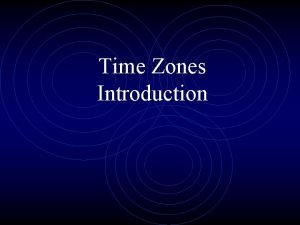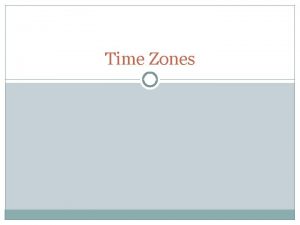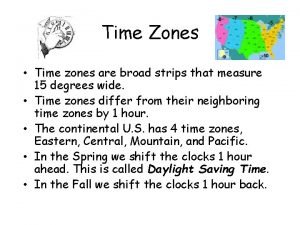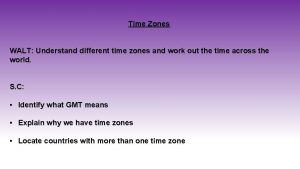International time zones The zones are approximately 15






- Slides: 6


International time zones The zones are approximately 15º wide and are 1 hour apart. (They do vary from country to country. For example Australian Central Standard Time is GMT + 9½h rather than GMT +9 h. New Zealand is in 1 time zone GMT +12 h rather than the two it “should” be in) The International Date Line, IDL, is approximately opposite Greenwich, but it is not a straight line. The line deviates through the pacific and between the USA and USSR. During daylight saving clocks are moved forward by 1 hour.

Example 1 Eliza leaves Sydney (GMT +10 h) at 9 am and flies to Perth (GMT +8 h). If the flight takes 5½h, what is the local time when she lands? Steps: 1) Work out the time difference between the 2 locations 2) Work out the local time at the destination 3) Add the time of flight to find the local landing time As the 2 cities are on the same side of the Greenwich meridian subtract to find the time difference. 1000 0800 = 0200 As Perth is west of Sydney subtract the time difference. 0900 0200 = 0700 Add the time of flight 0700 + 0530 = 1230 Eliza lands at 12: 30 pm Perth time.

Example 2 Tim leaves Buenos Aires (GMT 3 h) at 7 pm Friday and flies to Dacca (GMT +6 h). If the flight takes 14 h, what is the local time when he 1) Work out the time difference between the 2 locations lands? 2) Work out the local time at the destination 3) Add the time of flight to find the local landing time As the 2 cities are on different sides of the Greenwich meridian add to find the time difference. 0300 + 0600 = 0900 As Dacca is east of Buenos Aires add the time difference. 1900 + 0900 = 2800 = 0400 Saturday Add the time of flight 0400 + 1400 =1800 Tim lands at 6 pm Saturday Dacca time

Example 3 Imogen leaves Reykjavik (GMT 1 h) at 4 am Monday and flies to Anchorage (GMT 9 h). If the flight takes 11½h, what is the local time when she lands if Anchorage is using daylight saving time? 1) Work out the time difference between the 2 locations 2) Work out the local time at the destination 3) Add the time of flight to find the local landing time 4) Add time for daylight saving As the 2 cities are on the same side of the Greenwich meridian subtract to find the time difference. 0900 0100 = 0800 As Anchorage is west of Reykjavik subtract the time difference. 0400 0800 = 0400 = 2000 Sunday Add the time of flight 2000 + 1130 = 3130 = 0730 Monday Add 1 h for daylight saving 0730 + 0100 = 0830 Alisha lands at 8: 30 am Monday Anchorage time.

Today’s work Exercise 7 -05 Page 270 → 272 Q 1 → 4, 10, 13, 14 & 21 Just for fun Q 16, 17, 19 & 22 Friday’s work Exercise 7 -04 Page 265 → 266 Q 1 → 5, 7 → 10, 12 → 15 & 17











